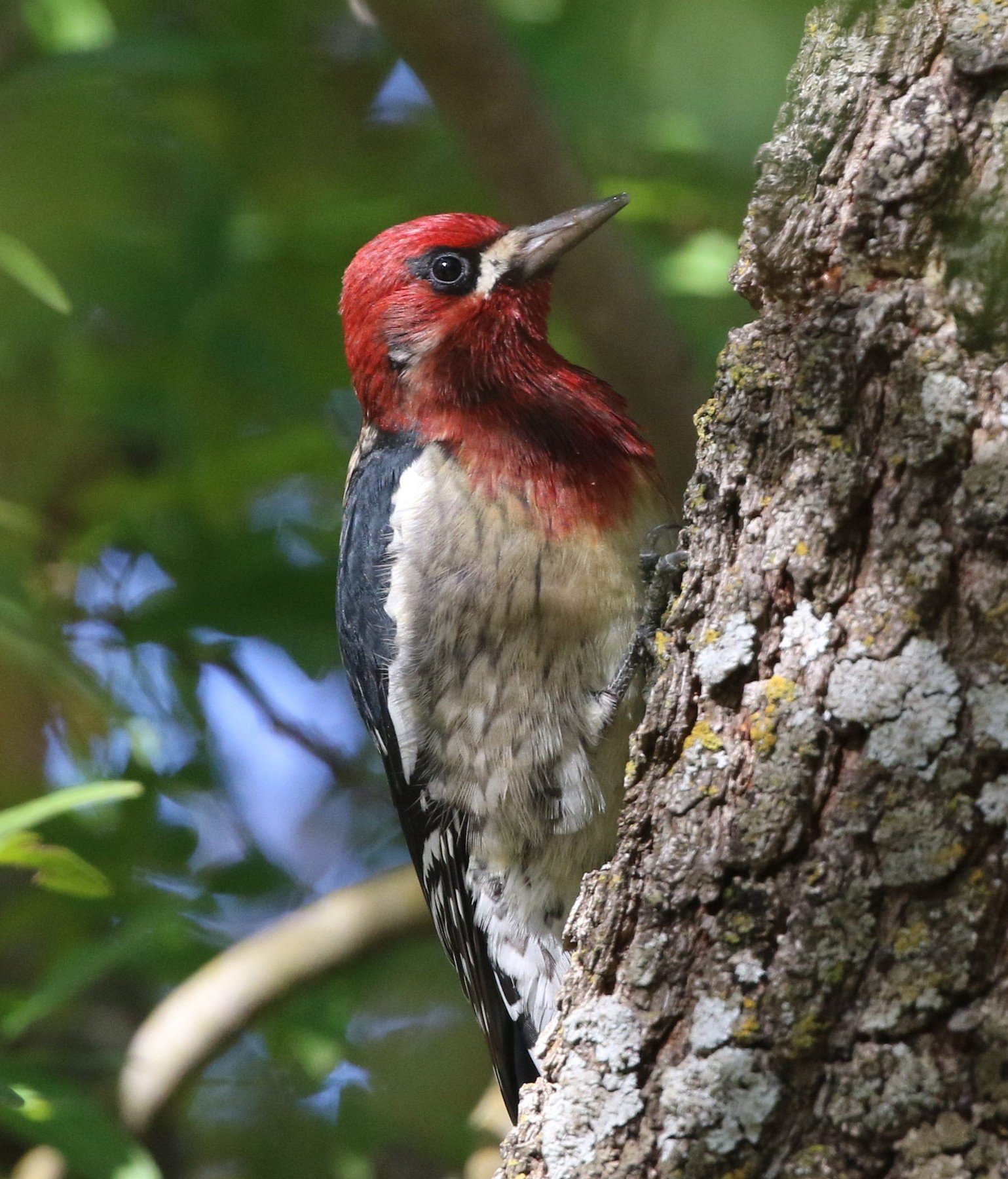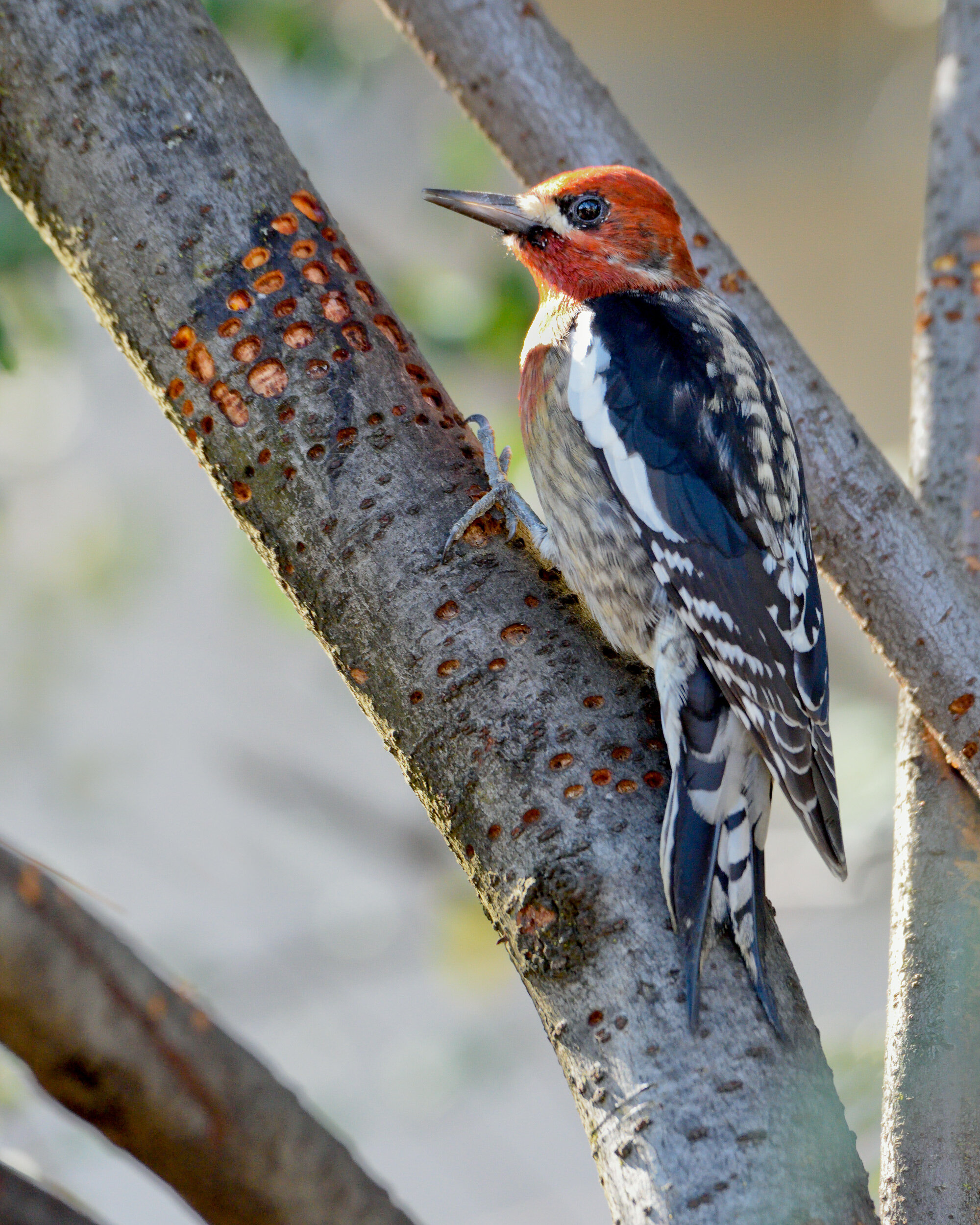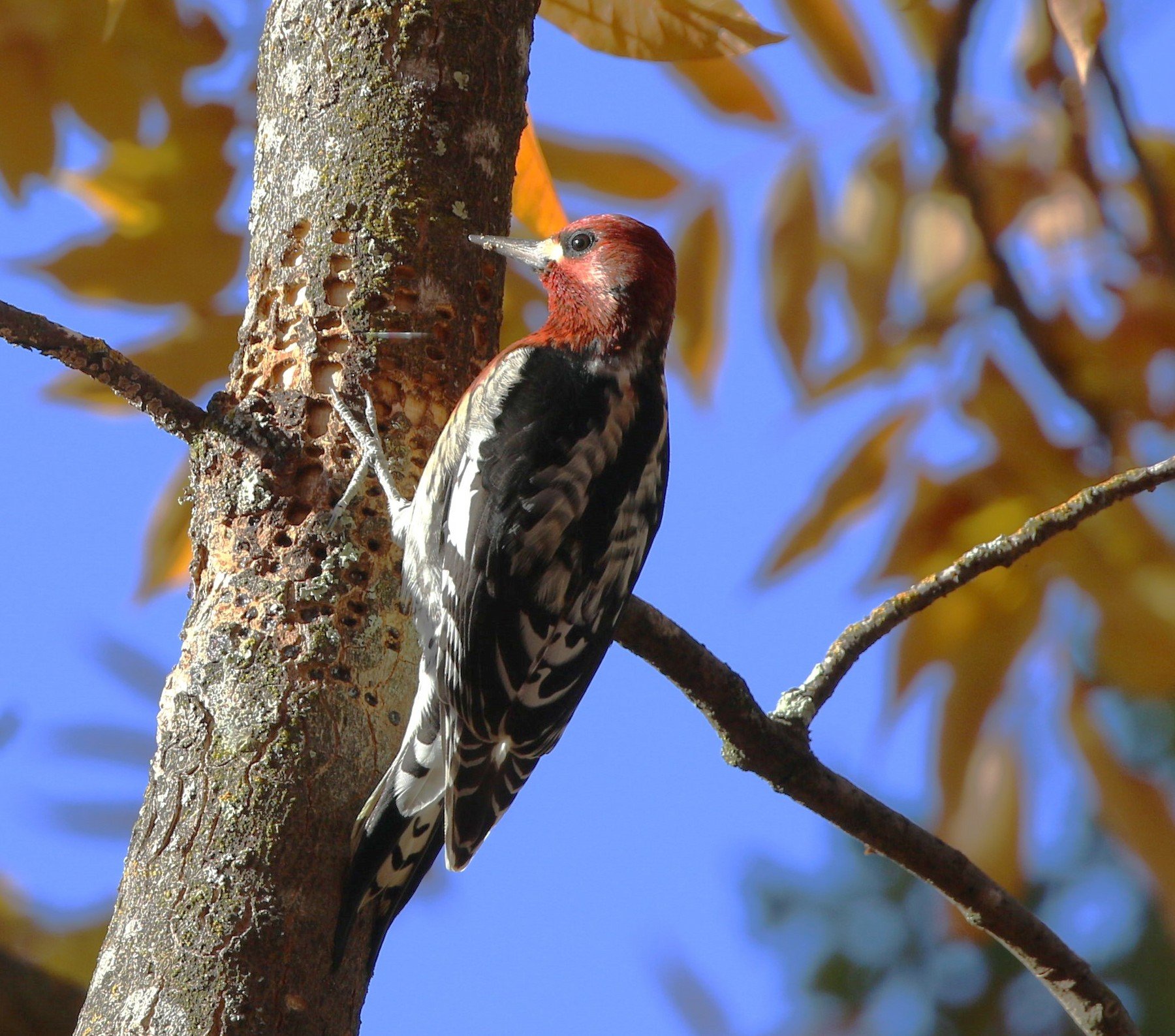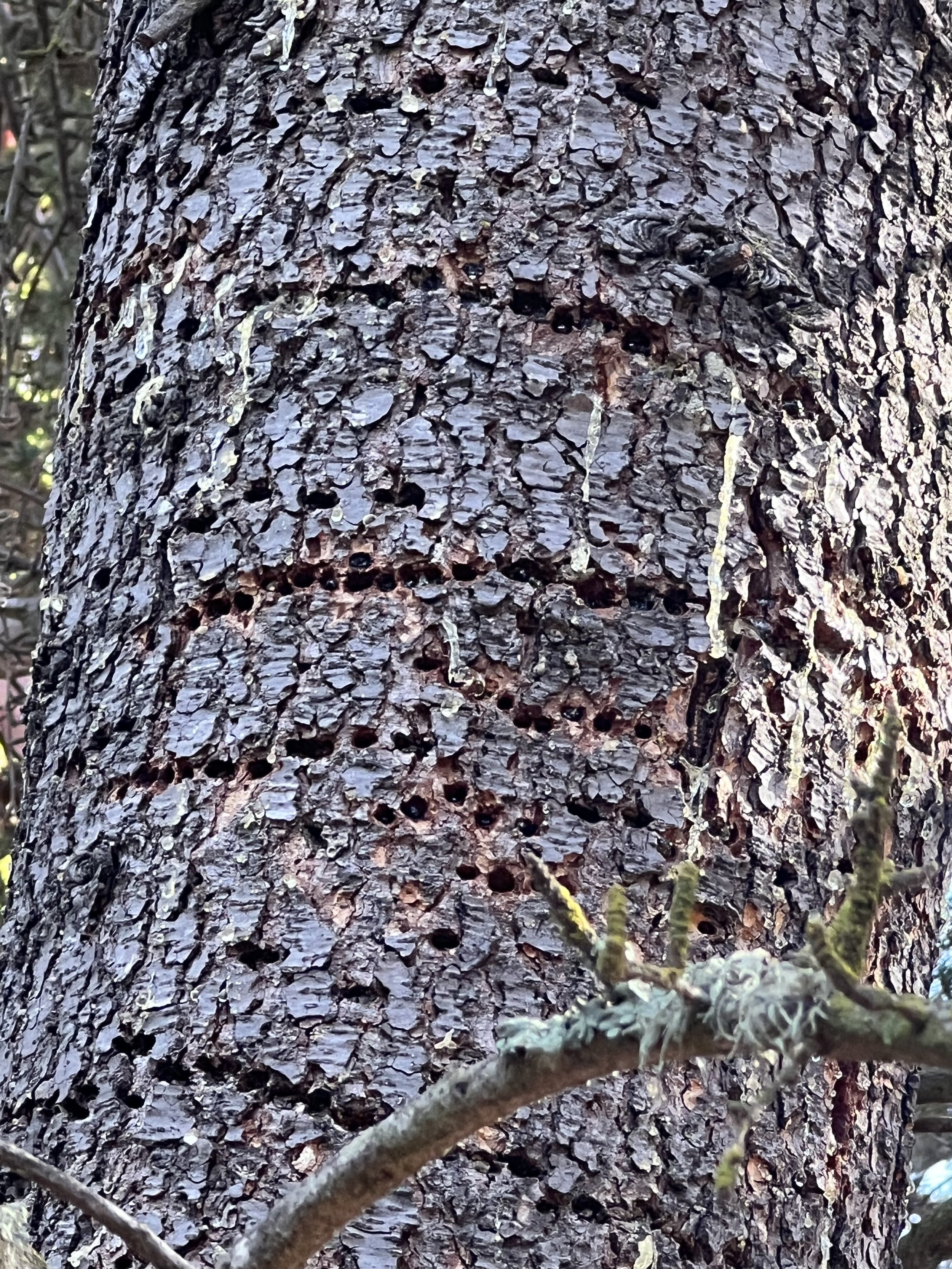Adult Red-breasted Sapsucker, Image by Kevin Thomas
This month let’s learn about a colorful woodpecker called the Red-breasted Sapsucker (Sphyrapicus ruber). Why are some woodpeckers named ‘sapsuckers’? It’s because sap is an important food source for sapsuckers; while other woodpeckers don't eat sap. Red-breasted Sapsuckers are closely related to both the Red-naped and the Yellow-bellied Sapsuckers. They were all considered to be the same species prior to 1983.
While some populations of Red-breasted Sapsuckers live in the same location year-round, others migrate (or change locations depending on the availability of food or the season). They will move to lower elevations or coastal regions to locate edible food when temperatures drop cold enough to freeze the sap.
In the Sacramento area, Red-breasted Sapsuckers are seen from late September through March. Look for these birds as they cling against tree trunks in their quest for food. Like other woodpeckers, Red-breasted Sapsuckers use a flight style that is referred to as undulating which is a combination of flapping and gliding. One source describes this type of flight as: “alternating a burst of wing flaps that make the birds rise, followed by a gentle descent with their wings tucked close to their bodies.” In the spring, the Red-breasted Sapsuckers wintering in the Sacramento Valley will migrate to their nesting region outside our local area.
What do Red-breasted Sapsuckers look like?
Adult Red-breasted Sapsucker, Image by Daniel Lee Brown
Red-breasted Sapsuckers are similar in size to an American Robin. Adult birds have completely red heads and chests. They have chisel-shaped bills, white rumps, black backs with lightly-colored spots, black tails with white barring, and black wings with a white patch running lengthwise. The area that is between the nostril and the eye, called the lore, is also bright white. Red-breasted Sapsuckers have white or light-yellow bellies with dark streaks on the sides. Female and male birds look similar; but some sources say that females have less red and more white. Juvenile Red-breasted Sapsuckers either have no red or very little red. Their head and chest are brown and have brownish-black backs and wings. Their wings have white patches similar to adult birds.
Where do Red-breasted Sapsuckers live?
Adult Red-breasted Sapsucker, Image by Kevin Thomas
Red-breasted Sapsuckers are found in the western regions of Canada, Alaska, Washington, Oregon, California, and the western tip of Mexico. They nest in the far western portions of Canada, Alaska, Oregon, and Washington, and northeastern California.
Red-breasted Sapsuckers are cavity nesters which means they nest inside tree holes. They frequently nest in mixed forests with both coniferous and deciduous trees. Red-breasted Sapsuckers seek dead tree snags (sharp, jagged projections) to drill nest cavities in. The cavities are often 50-60 feet high. Red-breasted Sapsucker pairs will drill out several cavities each nesting season. Afterwards, they pick one of these cavities to be their nest site. Whereas their nest cavity may be in the same tree as the previous year, Red-breasted Sapsuckers will not reuse old cavities. They usually only nest once per year. The entrance holes of their cavities are just large enough for the parent birds. This prevents most predators from entering. Red-breasted Sapsuckers can be quite territorial (or protective) of the area around their nest and are extremely dedicated parents. Both parents are active in the incubation of eggs (keeping the eggs warm by sitting on the eggs) and help raise and feed their young. The nestlings are fed every seven minutes for six days after hatching! Other nearby Red-breasted Sapsucker adults without nestlings of their own may help to feed the young. The nestlings are fed spiders, caterpillars, flies, sap, and fruit. The young leave the nest 23-28 days after hatching and their parents continue to feed them for about 10 days. Young birds are shown by the adults how to obtain and consume sap.
Horizontally-patterned tree wells made by a Red-breasted Sucker, Image by Jane Van Kessel
What do Red-breasted Sapsuckers eat?
As previously mentioned, the Red-breasted Sapsucker’s primary diet is tree sap. They consume a certain type of sap called phloem which has a high sugar and amino acid content. In search of sap, Red-breasted Sapsuckers drill shallow holes or wells in the trunks of a variety of tree species, such as aspen, cedar, pine, birch, or maple. They return to the same wells periodically to feed on the sap as it slowly oozes out. It is interesting to note that sapsuckers in general do not suck the sap out of tree wells, like their name implies. They simply lick or collect sap with their brush-like tongues. Red-breasted Sapsuckers will also conveniently eat insects that are attracted to the sap. Their entire bodies cling to tree trunks while they drill for sap or look to find insects in tree crevices (or narrow openings). Red-breasted Sapsuckers have stiff tail feathers that help brace their bodies close to tree trunks. They can also securely hold onto surfaces because their feet have strong claws, with two toes facing forward and two toes facing backwards. Besides sap, Red-breasted Sapsuckers eat spiders, caterpillars, berries, fruits, and tree cambium (the slender plant membrane located under the bark of a woody tree or plant). They sometimes will also catch insects in mid-air. Mammals, insects, and other birds benefit by feasting on the sap and trapped insects that are inside the tree wells made by sapsuckers.
What do Red-breasted Sapsuckers sound like?
Red-breasted Sapsucker calls have been described as a ‘mew’, ‘cheer’, ‘weep weep', ‘waa', or a ‘nasal squealing’ sound. One additional call is a chatter-like sound. Their bill-drumming sound has an irregular cadence (or beat) and has slower beats toward the end.
Like most bird species, Red-breasted Sapsuckers use their calls to establish territory or to find a mate. All species of sapsuckers tend to be quieter in the winter.
You can listen to the calls of Red-breasted Sapsuckers now.
These calls of the Red-breasted Sapsucker are from xeno-canto. More Red-breasted Sapsucker vocalizations can be found at xeno-canto.org/species/Sphyrapicus-ruber.




